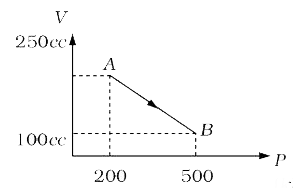The internal energy change when a system goes fromk state A to B is 40kJmol−1. If the system goes from A to B by a reversible path and returns to state A by an irreversible path, what would be the net change in internal energy?
<40kJ
Zero
40kJ
>40kJ
The correct Answer is:B
To solve the problem, we need to analyze the change in internal energy as the system transitions between states A and B, and then back to A.
1. Identify the Change in Internal Energy from A to B:
- The problem states that the internal energy change when the system goes from state A to state B is given as ΔUA→B=40kJ mol−1.
2. Understand the Nature of Internal Energy:
- Internal energy (U) is a state function. This means that the change in internal energy depends only on the initial and final states of the system, not on the path taken to get there.
3. Consider the Return Path from B to A:
- The system returns from state B back to state A. The path taken for this return is irreversible. However, since internal energy is a state function, the change in internal energy for this part of the process is also determined solely by the initial and final states.
4. Calculate the Change in Internal Energy for the Entire Process:
- For a complete cycle (from A to B and then back to A), the overall change in internal energy can be expressed as:
ΔUtotal=ΔUA→B+ΔUB→A
- Since the system returns to its initial state A, we have:
ΔUB→A=−ΔUA→B=−40kJ mol−1
- Therefore, the total change in internal energy is:
ΔUtotal=40kJ mol−1+(−40kJ mol−1)=0kJ mol−1
5. Conclusion:
- The net change in internal energy when the system returns to state A after going from A to B and back to A is 0kJ mol−1.
Final Answer:
The net change in internal energy is 0kJ mol−1.
---
- The problem states that the internal energy change when the system goes from state A to state B is given as ΔUA→B=40kJ mol−1.
- Internal energy (U) is a state function. This means that the change in internal energy depends only on the initial and final states of the system, not on the path taken to get there.
- The system returns from state B back to state A. The path taken for this return is irreversible. However, since internal energy is a state function, the change in internal energy for this part of the process is also determined solely by the initial and final states.
- For a complete cycle (from A to B and then back to A), the overall change in internal energy can be expressed as:
ΔUtotal=ΔUA→B+ΔUB→A
- Since the system returns to its initial state A, we have:
ΔUB→A=−ΔUA→B=−40kJ mol−1
- Therefore, the total change in internal energy is:
ΔUtotal=40kJ mol−1+(−40kJ mol−1)=0kJ mol−1
- The net change in internal energy when the system returns to state A after going from A to B and back to A is 0kJ mol−1.
The net change in internal energy is 0kJ mol−1.
Topper's Solved these Questions
- THERMODYNAMICS & THERMOCHEMISTRYBOOK - VMC MODULES ENGLISHCHAPTER - THERMODYNAMICS & THERMOCHEMISTRYEXERCISE - Efficient
48 Videos
- THERMODYNAMICS & THERMOCHEMISTRYBOOK - VMC MODULES ENGLISHCHAPTER - THERMODYNAMICS & THERMOCHEMISTRYEXERCISE - Impeccable
48 Videos
- THERMODYNAMICS & THERMOCHEMISTRYBOOK - VMC MODULES ENGLISHCHAPTER - THERMODYNAMICS & THERMOCHEMISTRYEXERCISE - Impeccable
48 Videos
- THERMODYNAMICSBOOK - VMC MODULES ENGLISHCHAPTER - THERMODYNAMICSEXERCISE - JEE ADVANCED (ARCHIVE)
44 Videos
Similar Questions
A system changes from state X to Y with a change in internal energy measuring to 25 kJ mol−1, by a reversible path and returns from Y to X by an irreversible path. What will be the net change in internal energy?
View Solution160 J of work is done on the system and at the same time 100 J of heat is given out. What is the change in the internal energy ?
View Solution
Knowledge Check
A system changes from state X to Y with a change in internal energy measuring to 25 kJ mol−1, by a reversible path and returns from Y to X by an irreversible path. What will be the net change in internal energy?
A25 kJB> 25 kJC< 25 kJDzeroThe internal energy U is a unique function of any state because change in U
Adoes not depend upon pathBdepends upon pathCcorresponds to an adiabatic processDcorresponds to an isothermal processA system absorbs 50 kJ heat and does 20 kJ of work. What is the net change in the internal energy of the system ?
AIncrease by 30 kJBDecrease by 30 kJCIncrease by 70 kJDDecrease by 70 kJ
180 J of work is done on the system and at the same time 120 J of heat is given out. What is the change in the internal energy?
View SolutionA mono-atomic gas is taken along path AB as shown. Calculate change in internal energy of the gas.

View SolutionCalculate ΔU, internal energy change of a system, if it absorbs 25kJ of heat and does 5kJ of work.
View SolutionIf 150 J of heat is added to a system and the work done by the system is 110 j. then change in internal energy wil be
View SolutionHow will you find the change in internal energy of a system when it melts ?
View Solution
